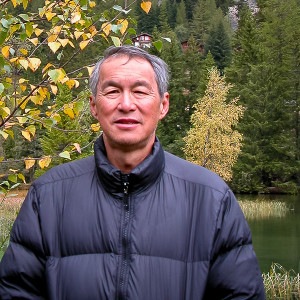One
一
Trading in “Cosmic Opulence” for “One?” My grandfather did just that by dropping the name given to him by his father in favor of “Emulating One,” the name he composed for himself, when he snipped off his braided queue at age seventeen to join Sun Yat-san’s Alliance Society making Molotov cocktails to be aimed at corrupt Qing officials and soldiers, in order to save his country from being carved up by the Europeans and Japanese. For seven decades he stayed true to his name, being loyal to his cause. Delving further into “one,” I have come to find it holding an essential metaphysical place in ancient texts from the Classic of Changes (Yi Jing) expressing the primordial beginning from nothingness before dividing into yin and yang and their subsequent multitudes to Laozi, where it represents universality, the unity of the multitude, hidden and revealed.
In this selection, I have translated five verses from Laozi into English along with the modern Mandarin pinyin. In order to appreciate how their words rhymed when they were composed two and a half millennia ago, I have also included the ancient (pre 221 BCE) phonetic rhyme groups to which the sinographs belonged. In the Prosody section, I examine their form and how they originally rhyme with each other in the Old Chinese reconstructions in the Baxter-Sagart system. I align the Chinese and English words side by side, so those who do not read Chinese can see the repeating characters and the parallel structures. In translating, I omit punctuation in order to follow the same form as the earliest texts, but deploy line, stanza, and chapter breaks to ease comprehensibility. I also endeavor to minimize my words in order to mimic the sparseness of the original text. I do not translate the character “Dao” with a literal meaning, such as “path” or “the way,” since most of the time Laozi uses it to express something far too encompassing.
Click the links below to read each verse, with prosody and annotation.
42 — The Supreme Ultimate.
39 — Before Duality.
22 — Embracing One.
10 — Return to One.
11 — The Vacuous One.
 Wong Yoo-Chong left his homes in Hong Kong and Taiwan to study architecture at the University of Michigan. While doing graduate studies in urban planning, he became acquainted with Laozi in a Chinese philosophy class. Forty years later, he has found its 2450-year-old verses even more relevant in today‘s world, prompting him to devote himself to the investigation of its history, prosody, philology, phonology, and philosophy. Recent research into ancient Chinese phonetics has enabled Wong to reunite the sounds with the meanings of this ancient text. Wong has also explored the commentaries on the verses made in the past two millennia in search for their diverse meanings. In the process Wong is attempting to synthesize the philology, phonology, and themes of the verses, which were most likely originated and transmitted as mnemonics before they were written down sometime during the fourth century BCE.
Wong Yoo-Chong left his homes in Hong Kong and Taiwan to study architecture at the University of Michigan. While doing graduate studies in urban planning, he became acquainted with Laozi in a Chinese philosophy class. Forty years later, he has found its 2450-year-old verses even more relevant in today‘s world, prompting him to devote himself to the investigation of its history, prosody, philology, phonology, and philosophy. Recent research into ancient Chinese phonetics has enabled Wong to reunite the sounds with the meanings of this ancient text. Wong has also explored the commentaries on the verses made in the past two millennia in search for their diverse meanings. In the process Wong is attempting to synthesize the philology, phonology, and themes of the verses, which were most likely originated and transmitted as mnemonics before they were written down sometime during the fourth century BCE.